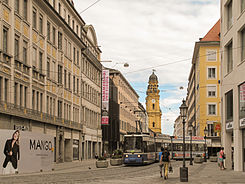Theatinerstrasse
| Theatinerstrasse | |
|---|---|
| Street in Munich | |
| Theatinerstrasse with a view of the Theatinerkirche | |
| Basic data | |
| place | Munich |
| District | Old town |
| Hist. Names | Rear Schwabinger Gasse |
| Connecting roads | Wine route |
| Cross streets | Brienner Strasse , Viscardigasse , Salvatorstrasse, Perusastrasse, Maffeistrasse |
| Places | Odeonsplatz |
| Buildings | see below |
| use | |
| User groups | Pedestrian traffic , bicycle traffic |
| Road design | Pedestrian zone |
| Technical specifications | |
| Street length | approx. 380 m |
The Theatinerstraße is a street in Munich's Old Town . It connects (like the parallel running Residenzstrasse ) the Odeonsplatz with the Marienhof to the south and houses a number of classical buildings as well as several shops. The street got its current name from the adjoining Theatine Church ; it used to be called "Hintere Schwabinger Gasse".
location
Theatinerstraße stretches south from Odeonsplatz to Marienhof. The Viscardigasse and Perusastraße connect it to the residence street in the east; Via Salvatorstraße or Maffeistraße you reach Kardinal-Faulhaber-Straße as a parallel street running to the west. At the junction of Schrammerstraße, Theatinerstraße merges into Weinstraße at the level of Marienhof, which then leads past the New Town Hall onto Marienplatz . The Theatinerstraße – Weinstraße is part of the medieval long-distance trade street running in north-south direction, which already existed when the city was founded in the 12th century and which crossed at Marienplatz with the east-west running salt street. The transition from the Weinstraße to the Theatinerstraße marks the border of the high medieval so-called Heinrichsstadt. The rear Schwabinger Tor , also called Wilbrechtsturm, was located there until 1691 . At the northern end of Theatinerstrasse, the Outer Schwabinger Tor stood until 1817 .
shopping street
Many international companies have branches in Theatinerstrasse, including Armani , Bassetti , Butlers , Zara , Esprit and Bose . There are also the Fünf Höfe here , which house another 60 shops, several restaurants and the art gallery of the Hypo-Kulturstiftung .
traffic
The entire Theatinerstraße has been declared a pedestrian zone and is not accessible for individual motorized traffic.
With the Munich subway, Theatinerstraße can be reached via the Odeonsplatz subway station using the U3, U4, U5 and U6 lines. There is also a bus stop at Odeonsplatz, which is served by the N40, N41 and 100 lines. For the Munich tram, there is the Theatinerstraße stop at the corner of Maffeistraße , which is served by lines 19 and 21.
Attractions
Unlike Kardinal-Faulhaber-Strasse and even more so than Residenzstrasse, which both run almost parallel, Theatinerstrasse has changed its face significantly since the Second World War. Many buildings worth seeing were destroyed, including the Palais Piosasque de Non by François de Cuvilliés . Other aristocratic palaces lost in the war are the Palais Kuen-Belassy at Theatinerstraße 19, probably built around 1725 by Joseph Effner , and the baroque Palais Berchem by Enrico Zuccalli at Theatinerstraße 20. The Mielich House , named after Hans Mielich , is also bombed at number 10 was rebuilt under Count Felix to Törring-Jettenbach 1747–54. The rococo facade was one of the most beautiful in the city. However, some baroque houses were already lost in the building boom at the beginning of the twentieth century. One example is the Palais Tattenbach at Theatinerstraße 6, built in 1770 and demolished in 1910. These buildings are still located on Theatinerstraße today:
The Theatinerpassage, built by Jean Ehrhard in 1954/55, which connects Theatinerstraße 32 with Residenzstraße 23, has been home to the Theatiner Filmkunst cinema since 1956 (architect: Hanns Atzenbeck). Characteristic of the interior of the passage are the upward curved flight of stairs and the fanned glass roof. The cinema, which has been showing cinematic art for over 60 years, is a listed building along with its equipment. At Theatinerstraße 38, a commercial building designed by Max Littmann in 1903 with a sandstone facade borrowed from the Viennese Baroque survived the war .
Web links
Individual evidence
- ↑ Theatinerstraße , muenchen.de, accessed on July 7, 2013
- ↑ Bavarian Monument Atlas, http://www.blfd.bayern.de/ , file no. D-1-62-000-7898
- ^ Dunja Bialas: Cinemas in Munich - Das Theatiner. In: artechock.de. Artechock eV, May 23, 2013, accessed on June 23, 2019 .
Coordinates: 48 ° 8 ′ 24 ″ N , 11 ° 34 ′ 35 ″ E



